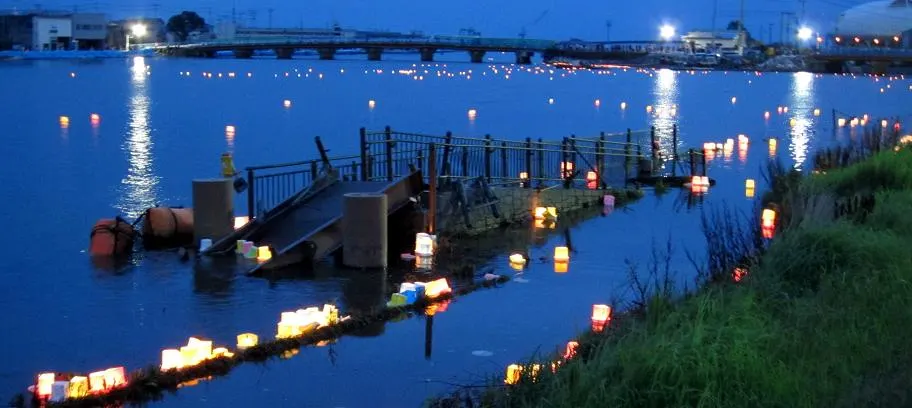Part Two of my account of working as a volunteer in Ishinomaki, a town hard-hit by the earthquake/tsunami of March 11th 2011, as part of clean-up and recovery efforts.
~
7/31 – 4am: awoke to a strong aftershock. Movement and whispers in tents. Ready to go. Shaking halts. 6.4 in Fukushima. No tsunami alert. We sleep.
Today is the beginning of two important days in Ishinomaki, the first day of the Kawabiraki Festival, an annual event to give thanks for the blessings from the river and to honour ancestral spirits. The largest Summer festival in Ishinomaki, this event usually sees 500 lanterns released into the river to recognize and honour those who have passed away over the past year. Given the enormity of the events of March 11th, this year 10,000 would be released. Not everyone wanted this event to happen this year. Too soon. Too painful. In the end though, with concerted efforts from Ishinomaki City, the Chamber of Commerce and the local people, the annual event that was always marked on the calendar would liven the streets and the river yet again. Commemoration on a mass scale. A sign of recovery and hope. It was our job to support the local community in this endeavour.
We took a bus into town and followed the stairs up onto the rooftop. Our task: to waterproof the 10,000 lantern bases that would be placed into the water that evening. Masks on, we sprayed, ran up and down the stairs, laid them to dry, packed them into boxes. Spirit. Team work. Two hours. Those 10,000 lanterns would make their way into the water that night.
Back at camp, we changed out of our working gear and the two of us went for a walk outside the university grounds where we were staying. A lady emerged from an elevated garden bed, calling out, eager to speak with us. “Are you volunteers?” “Yes”. An earnest and low bow showed her appreciation. “Are you a couple?” “Yes, we are married.” She clapped and a wide smile came across her face. “Ii ne?!” (That’s good, isn’t it?) She came down to street level. “Do you like blueberries?” “Yes”. “I have many. Please eat them”, she said as she pulled them off the bush that ran along her fence. “Mmmm oishii (delicious)”, we told her with nodding approval. “Eat more”. “Oh, that’s OK really”. “Please take more”. She gestured towards the bush. We took another, running our fingers along them to brush away the cobwebs. “Don’t worry, there are no insects on them. What are you doing now? Are you going to the festival tonight?” “Yes”, we replied. “We will remember the dead but who knows how many thousands of people have passed. The exact number we still don’t know. It wasn’t the earthquake that hurt us you know, it was the tsunami”, as she gestured a huge wall of water with an anguished face. “Will you come into my garden? I have tomatoes. Do you like them? Please take some. Oishii yo (They’re good)”. A bag of tomatoes in hand, we thanked her and departed down the road.
Later that evening in town, people were out in the streets. Vendors dotted the streets bringing with it the familiar smell of the usual matsuri (festival) favourites. People were spending. Money was changing hands. I even tried my hand and balance at suikawari (watermelon splitting), a Japanese game where you are blind-folded, you spin around several times, and then holding a stick and with the direction of onlookers, you try to make your way to a whole watermelon placed on the ground. When you think you are lined up, you take a swing at it. Usually the winner is the person who can split the watermelon open and then the fruit is shared among everyone. In this version, we simply tried to hit the watermelon, not as easy as it sounds, and winners received a slice of (another) juicy fruit in return. I happily tucked into my refreshing slice, soaking in the atmosphere of a town crawling back.
Down by the river, people starting lining the river’s edge. A man invited us to assist with lighting the many candles that marked the ceremony area. As dusk descended, the first of the lanterns started floating toward us. A genki (energetic) young girl played happily with a boy beside me. “Just pray for your father”, her mother told her. Another woman arrived only to leave several minutes later. “I can’t look at the water”, she muttered. As daylight disappeared, monks continued to receive offerings at the head of the ceremony area. We offered a prayer. We continued further along the river, the lanterns so much brighter now in the darkness. A young girl stood with her mother. “Are these lanterns for all the people who died Mama?” “Yes”, she replied. “Ippai shinda Mama, ippai shinda” (So many people died, Mum, so many people died), she said in a voice that I imagined accompanied wide eyes. A young girl who couldn’t count up to the thousands yet suddenly got a visual representation of what 10,000 means: each lantern, two people. The monks chanted louder and louder out into the night. In silence, I closed my eyes, tears streaming down my face and offered a prayer for those the twinkling lights on the water represented. With the monks continuing to call out the names of the dead, a solemn walk home.

